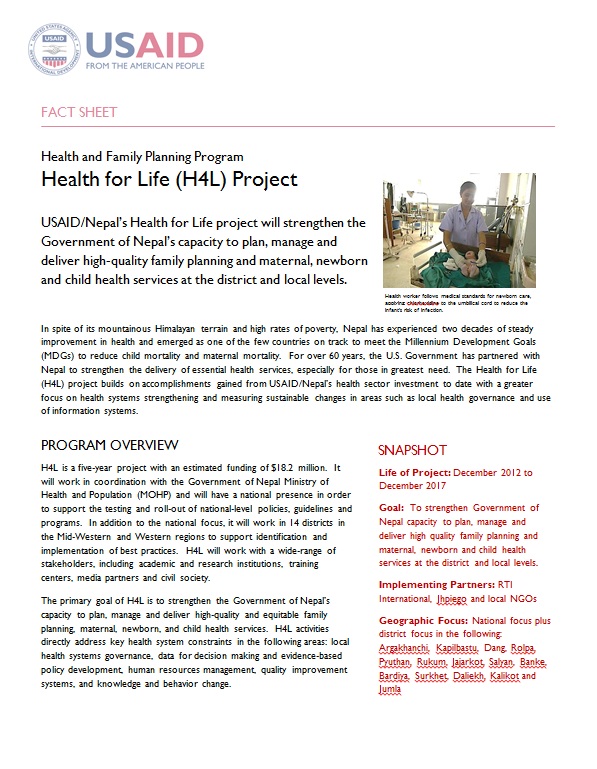Speeches Shim
In spite of its mountainous Himalayan terrain and high rates of poverty, Nepal has experienced two decades of steady improvement in health and emerged as one of the few countries on track to meet the Millennium Development Goals (MDGs) to reduce child mortality and maternal mortality. For over 60 years, the U.S. Government has partnered with Nepal to strengthen the delivery of essential health services, especially for those in greatest need. The Health for Life (H4L) project builds on accomplishments gained from USAID/Nepal’s health sector investment to date with a greater focus on health systems strengthening and measuring sustainable changes in areas such as local health governance and use of information systems.
Health 4 Life (H4L) Project ![]() (docx - 421k)
(docx - 421k)
PROGRAM OVERVIEW
H4L is a five-year project with an estimated funding of $18.2 million. It will work in coordination with the Government of Nepal Ministry of Health and Population (MOHP) and will have a national presence in order to support the testing and roll-out of national-level policies, guidelines and programs. In addition to the national focus, it will work in 14 districts in the Mid-Western and Western regions to support identification and implementation of best practices. H4L will work with a wide-range of stakeholders, including academic and research institutions, training centers, media partners and civil society.
The primary goal of H4L is to strengthen the Government of Nepal’s capacity to plan, manage and deliver high-quality and equitable family planning, maternal, newborn, and child health services. H4L activities directly address key health system constraints in the following areas: local health systems governance, data for decision making and evidence-based policy development, human resources management, quality improvement systems, and knowledge and behavior change.
PROGRAM OBJECTIVES
- Support development and implementation of national evidence-based policy, including the National Health Sector Plan III
- Improve health system governance of district health offices and sub-district level facilities
- Institutionalize nationwide system to improve the quality of health service delivery, which includes setting standards of care as well as establishing a system for assessing and then addressing areas for improvement
- Improve capacity of district and local health workers and community volunteers to deliver high-quality family planning, maternal, newborn, child health and nutrition services
- Improve knowledge, behavior and use of health services among adolescents and marginalized groups
PROGRAM ACTIVITIES
- Strengthen health facility operations and management committees at the district and local level
- Build the capacity of local government officials to better manage health care services and to incorporate community and client feedback through mechanisms such as social audits, in which citizens have the opportunity to dialogue with facility staff and local government officials about the quality of public services
- Establish and strengthen mechanisms for evidence-based, timely decision making in order to respond effectively to local needs
- Test and scale-up a health service quality improvement and assurance system suitable for the conditions in Nepal
- Improve quality pre-service trainings for Auxiliary Nurse Midwives and enhance clinical skills of lower-level health workers
- Address equitable access to health services by making information about health behaviors available, especially to historically underserved groups
KEY RESULTS
H4L is expected to build on the successes of past USAID programs and contribute to improvements in Nepal’s neonatal mortality rate, maternal mortality rate, modern contraceptive prevalence rate, health information system performance index, disparity between richest and poorest quintiles in use of specific services and participation in governance-related activities at the local level.
H4L will support the Government of Nepal to achieve the following results:
- Health facility operations and management committees effectively manage facilities and contribute to improved quality of care
- District and regional MOHP review meetings effectively use data to identify and monitor actions to improve performance
- National Health Research Council leads collaborative process with academics, practitioners and donors to prioritize studies for a national research agenda
- Facility-based quality improvement system is institutionalized
- Pre-service training and teaching methods for Auxiliary Nurse Midwives strengthened
- Use of maternal, newborn, child health and family planning services increased among adolescents and disadvantaged groups
- Gender-based violence and early marriage reduced


Comment
Make a general inquiry or suggest an improvement.